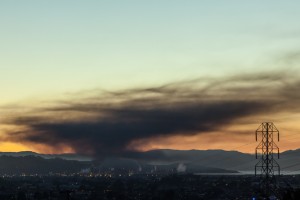
Since Monday's fire erupted just after 6pm, more than 600 people have been treated in emergency departments at Kaiser in Richmond and Doctors Medical Center in nearby San Pablo for symptoms caused by the Chevron refinery fire.
One of them was Point Richmond resident Cheri Edwards. “The smoke was kind of like an oily smell, it was an oily smell, and I have asthma really bad. And right now I’m at the bus stop trying to go to Kaiser because I have been having respiratory problems."
Besides breathing problems, people also reported symptoms including sore throats and watery eyes. These symptoms are consistent with exposure to "a full toxic soup of hundreds, probably thousands, of combustion products and byproducts," Greg Karras, senior scientist with the advocacy group Communities for a Better Environment, told a Forum audience Tuesday morning.
Richmond is a low socioeconomic community with a high proportion of African American residents that suffers disproportionate rates of asthma and other illnesses. Living near major refineries adds to negative health impacts. "The cumulative impact of all of the pollution in this overburdened community where there's been a legacy of environmental racism frankly, is also part of the puzzle," Karras told me in an interview following Forum.
In a phone interview, Randy Sawyer director of Contra Costa Health Services Hazardous Materials Program agreed that "there's all kinds of chemicals that can be in the fire. But the biggest concern that we had last night was the particulates in the smoke because they can lodge in your lungs."